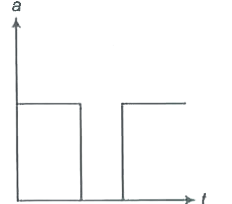Velocity - time graph of a moving object is shown below. What is the acceleration of the object? Also draw displacement - time graph for the motion of the object?Solution in Tamil
The given graph shows that the velocity of the object is constant. That 
is, the velocity of the object is not changing, so the acceleration of the object is zero. Since the acceleration of an object is given by
a=Change in velocityTime taken

Displacement - time graph for the motion of the object is shown in the figure above.
Topper's Solved these Questions
- SAMPLE PAPER -6 (SOLVED)Book:FULL MARKSChapter:SAMPLE PAPER -6 (SOLVED)Exercise:PART-III
Explore 9 Videos
- SAMPLE PAPER -6 (SOLVED)Book:FULL MARKSChapter:SAMPLE PAPER -6 (SOLVED)Exercise:PART-IV
Explore 12 Videos
- SAMPLE PAPER -6 (SOLVED)Book:FULL MARKSChapter:SAMPLE PAPER -6 (SOLVED)Exercise:PART-IV
Explore 12 Videos
- SAMPLE PAPER -4Book:FULL MARKSChapter:SAMPLE PAPER -4Exercise:PART-IV
Explore 10 Videos
- SAMPLE PAPER 11 (UNSOLVED)Book:FULL MARKSChapter:SAMPLE PAPER 11 (UNSOLVED)Exercise:Part IV
Explore 10 Videos
Similar Questions
Centripetal acceleration is given by
View SolutionObtain an expression for the time period T of a simple pendulum. [The time period T depend upon (i) mass l of the bob (ii) length m of the pendulum and (iii) acceleration due to gravity g at the place where pendulum is suspended.
Assume the constant k=2π]
View SolutionObtain an expression for the time period T of a simple pendulum. [The time period T depend upon (i) mass l of the bob (ii) length m of the pendulum and (iii) acceleration due to gravity g at the place where pendulum is suspended.
Assume the constant k=2π]
View SolutionAt the highest point of oblique projection, which of the following is correct?
View SolutionObtain in expression for the time period T of a simple pendulun. The time period depend upon (i) mass 'm' of the bob (ii) length 'l' of the pendulum and (iii) acceieration due to gravity g at the place where the pendulum is suspended. (Constant k = 2π ) i.e.
View SolutionThe position-time (x-t) graph of an object in uniform motion is shown below. Calculate the velocity with which the object is moving.
View SolutionDraw the velocity-time graph of an object moving with uniform positive acceleration.
View SolutionDraw the velocity-time graph of an object moving with uniform negative acceleration.
View SolutionThe velocity-time graph of an object is shown below. The acceleration of the object is
View Solutionवेग - समय ग्राफ के नीचे का ………… वस्तु का विस्थापन देता है ।
View Solutionएक वस्तु एक नियत त्वरण से गतिशील है । इस वस्तु की गति का समय-त्वरण , समय वेग एवं एवं-समय -विस्थापन आरेख बनाइए।
View Solutionनिम्नांकित चित्र (a) में एक गतिशील वस्तु का समय-विस्थापन ग्राफ प्रदर्शित हैं । इसकी सहायता से इसका वेग-समय ग्राफ बनाइए और इस ग्राफ से समझाइए कि :

(i) वस्तु सबसे तेज किस समय-अन्तराल में चल रही थी ?
(ii) वस्तु ने कुल कितनी दूरी तय की ?
(iii) वस्तु का सम्पूर्ण विस्थापन कितना है?
(iv) आरम्भ से बिन्दु A तक वस्तु का त्वरण कितना है ?
View Solutionचित्र में किसी वस्तु के लिए त्वरण-समय ग्राफ प्रदर्शित किया गया है। इसी वस्तु के लिए वेग-समय ग्राफ होगा

View Solutionकिसी गतिशील वस्तु का वेग-समय ग्राफ चित्र में दर्शाया गया है। उस समयान्तराल में, जिसमें वस्तु का त्वरण तथा मंदन अशून्य रहता है, कुल विस्थापन है

View Solutionप्रक्कथन : उच्च वेग से गति करती हुई वस्तु के विस्थापन समय ग्राफ का ढाल कम वेग से गति करती हुई वस्तु के विस्थापन-समय ग्राफ के ढाल से तीव्र (अधिक) होता है।
कारण : विस्थापन-समय ग्राफ का ढाल = वस्तु का वेग।
View Solution

